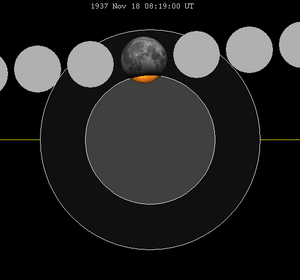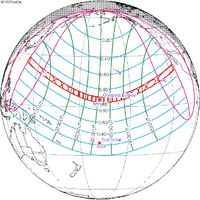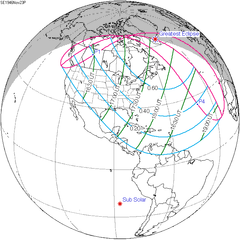November 1937 lunar eclipse
| Partial eclipse | |||||||||||||
 The Moon's hourly motion shown right to left | |||||||||||||
| Date | November 18, 1937 | ||||||||||||
|---|---|---|---|---|---|---|---|---|---|---|---|---|---|
| Gamma | 0.9421 | ||||||||||||
| Magnitude | 0.1443 | ||||||||||||
| Saros cycle | 115 (53 of 72) | ||||||||||||
| Partiality | 81 minutes, 19 seconds | ||||||||||||
| Penumbral | 254 minutes, 32 seconds | ||||||||||||
| |||||||||||||
A partial lunar eclipse occurred at the Moon’s descending node of orbit on Thursday, November 18, 1937,[1] with an umbral magnitude of 0.1443. A lunar eclipse occurs when the Moon moves into the Earth's shadow, causing the Moon to be darkened. A partial lunar eclipse occurs when one part of the Moon is in the Earth's umbra, while the other part is in the Earth's penumbra. Unlike a solar eclipse, which can only be viewed from a relatively small area of the world, a lunar eclipse may be viewed from anywhere on the night side of Earth. Occurring only about 18 hours before perigee (on November 19, 1937, at 0:30 UTC), the Moon's apparent diameter was larger.[2]
Visibility
The eclipse was completely visible over much of northeast Asia, North America, and northwestern South America, seen rising over east Asia and Australia and setting over much of South America, west Africa, and western Europe.[3]
 
|
Eclipse details
Shown below is a table displaying details about this particular solar eclipse. It describes various parameters pertaining to this eclipse.[4]
| Parameter | Value |
|---|---|
| Penumbral Magnitude | 1.11408 |
| Umbral Magnitude | 0.14432 |
| Gamma | 0.94213 |
| Sun Right Ascension | 15h32m59.8s |
| Sun Declination | -19°09'44.0" |
| Sun Semi-Diameter | 16'11.0" |
| Sun Equatorial Horizontal Parallax | 08.9" |
| Moon Right Ascension | 03h32m24.7s |
| Moon Declination | +20°06'50.3" |
| Moon Semi-Diameter | 16'41.3" |
| Moon Equatorial Horizontal Parallax | 1°01'14.9" |
| ΔT | 23.9 s |
Eclipse season
This eclipse is part of an eclipse season, a period, roughly every six months, when eclipses occur. Only two (or occasionally three) eclipse seasons occur each year, and each season lasts about 35 days and repeats just short of six months (173 days) later; thus two full eclipse seasons always occur each year. Either two or three eclipses happen each eclipse season. In the sequence below, each eclipse is separated by a fortnight.
| November 18 Descending node (full moon) |
December 2 Ascending node (new moon) |
|---|---|
 |

|
| Partial lunar eclipse Lunar Saros 115 |
Annular solar eclipse Solar Saros 141 |
Related eclipses
Eclipses in 1937
- A penumbral lunar eclipse on May 25.
- A total solar eclipse on June 8.
- A partial lunar eclipse on November 18.
- An annular solar eclipse on December 2.
Metonic
- Preceded by: Lunar eclipse of January 30, 1934
- Followed by: Lunar eclipse of September 5, 1941
Tzolkinex
- Preceded by: Lunar eclipse of October 7, 1930
- Followed by: Lunar eclipse of December 29, 1944
Half-Saros
- Preceded by: Solar eclipse of November 12, 1928
- Followed by: Solar eclipse of November 23, 1946
Tritos
- Preceded by: Lunar eclipse of December 19, 1926
- Followed by: Lunar eclipse of October 18, 1948
Lunar Saros 115
- Preceded by: Lunar eclipse of November 7, 1919
- Followed by: Lunar eclipse of November 29, 1955
Inex
- Preceded by: Lunar eclipse of December 7, 1908
- Followed by: Lunar eclipse of October 29, 1966
Triad
- Preceded by: Lunar eclipse of January 17, 1851
- Followed by: Lunar eclipse of September 18, 2024
Lunar eclipses of 1937–1940
This eclipse is a member of a semester series. An eclipse in a semester series of lunar eclipses repeats approximately every 177 days and 4 hours (a semester) at alternating nodes of the Moon's orbit.[5]
The penumbral lunar eclipse on March 23, 1940 occurs in the next lunar year eclipse set.
| Lunar eclipse series sets from 1937 to 1940 | ||||||||
|---|---|---|---|---|---|---|---|---|
| Ascending node | Descending node | |||||||
| Saros | Date Viewing |
Type Chart |
Gamma | Saros | Date Viewing |
Type Chart |
Gamma | |
| 110 | 1937 May 25
|
Penumbral
|
−1.1582 | 115 | 1937 Nov 18
|
Partial
|
0.9421 | |
| 120 | 1938 May 14
|
Total
|
−0.3994 | 125 | 1938 Nov 07
|
Total
|
0.2739 | |
| 130 | 1939 May 03
|
Total
|
0.3693 | 135 | 1939 Oct 28
|
Partial
|
−0.4581 | |
| 140 | 1940 Apr 22
|
Penumbral
|
1.0741 | 145 | 1940 Oct 16
|
Penumbral
|
−1.1925 | |
Half-Saros cycle
A lunar eclipse will be preceded and followed by solar eclipses by 9 years and 5.5 days (a half saros).[6] This lunar eclipse is related to two partial solar eclipses of Solar Saros 122.
| November 12, 1928 | November 23, 1946 |
|---|---|

|

|
See also
Notes
- ^ "November 17–18, 1937 Partial Lunar Eclipse". timeanddate. Retrieved 18 December 2024.
- ^ "Moon Distances for London, United Kingdom, England". timeanddate. Retrieved 18 December 2024.
- ^ "Partial Lunar Eclipse of 1937 Nov 18" (PDF). NASA. Retrieved 18 December 2024.
- ^ "Partial Lunar Eclipse of 1937 Nov 18". EclipseWise.com. Retrieved 18 December 2024.
- ^ van Gent, R.H. "Solar- and Lunar-Eclipse Predictions from Antiquity to the Present". A Catalogue of Eclipse Cycles. Utrecht University. Retrieved 6 October 2018.
- ^ Mathematical Astronomy Morsels, Jean Meeus, p.110, Chapter 18, The half-saros
External links
- 1937 Nov 18 chart Eclipse Predictions by Fred Espenak, NASA/GSFC



